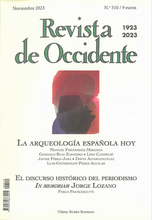CCS Faculty Fellow Javier Pérez Jara has published, along with Lino Camprubí, a paper on cultural sociology, “La arqueología como arqueología y la relativa independencia de la cultura” (“Archeology as archeology and the relative independence of culture”) in Revista de Occidente (510, November 2023), a famous cultural journal in Spain and Latin America founded by Ortega y Gasset in 1923.
The paper presents in a divulgative way the meaning of cultural sociology’s thesis of the relative independence of culture in the context of archeology. Specifically, it focuses on the following problem: If, contrary to what biological and other reductionisms claim, the socially learned symbolic depth of an object or process cannot be deduced from its aesthetic surface, how can archeology try to reconstruct what certain objects and processes meant for non-literary societies or whose writing system we do not understand?
Following iconicity theory, we emphasize that the concept of culture must be broadened beyond classic anthropology and sociology since the symbolic depth of the sun, the moon, or the forests for a given society is as cultural as its artifacts and rituals. In non-literary societies (or societies with unknown writing systems) that are now extinct, there are no direct methods to unearth, along with their physical relics, their meanings about the sacred, the profane, and the mundane that structured their understanding of natural and social events. We only have indirect methods, such as contextual and comparative ones (and, at least from Hodder onwards, rivers of ink have been spilled about their limits). Contextual archaeological methodologies are important, for example, to determine what an object was not (due to its size and shape, composition material, place where it was found, etc.). However, that negative knowledge still leaves a great degree of uncertainty, and analogies with other, better-known societies frequently lead to equivocal answers. Making Ancient icons speak is often a devilishly difficult task. By stressing the arbitrary, socially constructed connection between the symbolic depth of an object or process and its aesthetic surface, the paper contributes to the critique of Marxist and processual archeology from a cultural-sociological approach.
